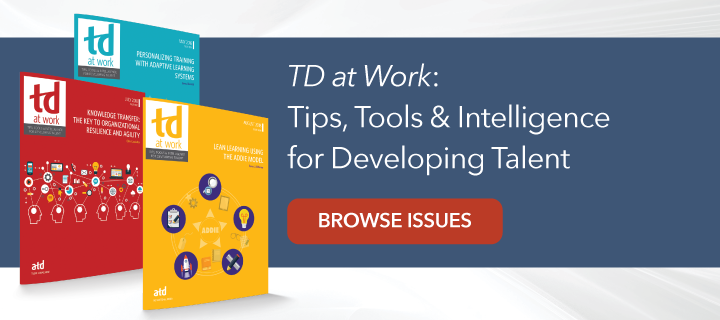Learning and development professionals no longer simply provide training. They are now performance consultants, wearing many hats. Among their responsibilities are contributing to:
- transactional solutions: identifying and addressing the needs of individual employees or learners.
- tactical solutions: identifying and addressing the needs of work groups.
- strategic solutions: identifying and addressing the needs of the organization or business.
During the ATD 2019 session, “Design Your Department to Deliver Strategic (Not Only Tactical) Results,” Chris Adams provided an extensive framework for doing so.
Many times, the L&D professional is asked for a training solution, approached by a point of contact who has little clout. However, when you’re serving as a strategic partner, your client has the authority to make or implement decisions and solutions. What’s more, the partner can obtain the resources required to carry out the work.
Seeing Yourself—and Your Role—Differently
Adams explained that to work strategically as a performance consultant, all the items below must be true:- There is a business need.
- The consultant has direct access to the true client—that is, the person who owns the business and performance needs.
- The client seeks performance change or improvement of people in one or more employee groups—that is, a group of people who share a common job or role and contribute to the achievement of the business goal through their regular performance.
- The client is willing to share accountability for producing change.
- The client will provide the consultant with time and access to the appropriate people who can provide the required information prior to taking action.
- The situation focuses on a group of employees rather than just one or two individuals.
As the L&D function is increasingly asked to prove their worth, they need to think more strategically and work to become strategic partners by working with business owner clients.
Undertaking the Strategic Partnership
Indeed, the strategic talent development process, Adams explains, begins with that partnership phase. The L&D pro would be wise to deepen partnerships with business leaders and seek to identify strategic opportunities both reactively and proactively to make a difference in performance.Following the partnership phase, the second step of the strategic process is the assessment phase. This involves defining performance requirements, identifying gaps and causes of those gaps, and reporting results of that assessment to the client. At that point, you can jointly agree on solutions to be taken.
After agreeing on the path forward, the next step, which should be familiar to most L&D practitioners, is the implementation phase. This is where solutions are designed and piloted. How will those solutions be measured? A critical component of this step ties back to the relationships with the business client, who should be actively involved in implementing the solutions that you have jointly agreed upon.
The final phase is the measurement phase. What results have you seen, using the measurement metrics that you previously decided upon? Report your findings to the client, and determine what further actions need to be taken to sustain or improve results.
Not All Performance Solutions Will Be Strategic
Even with the shift to the strategic process, the transactional and tactical work that L&D practitioners leads isn’t going to go away. That means that the manager of the talent development team needs to consider the skills and roles she requires on that team. For the strategic work, for example, the talent team may need a client liaison, a project manager, and impact evaluator, among others. For the tactical work that is still a legitimate requirement of the talent development function, roles such as facilitator, program designer, and learning materials developer will be required.Learn more about designing talent development solutions with the end results in mind in the September 2019 issue of TD at Work written by Chris Adams and co-author Beth Hughes.




